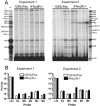Alpha/beta interferons regulate murine gammaherpesvirus latent gene expression and reactivation from latency
- PMID: 16254350
- PMCID: PMC1280204
- DOI: 10.1128/JVI.79.22.14149-14160.2005
Alpha/beta interferons regulate murine gammaherpesvirus latent gene expression and reactivation from latency
Abstract
Alpha/beta interferon (IFN-alpha/beta) protects the host from virus infection by inhibition of lytic virus replication in infected cells and modulation of the antiviral cell-mediated immune response. To determine whether IFN-alpha/beta also modulates the virus-host interaction during latent virus infection, we infected mice lacking the IFN-alpha/beta receptor (IFN-alpha/betaR(-/-)) and wild-type (wt; 129S2/SvPas) mice with murine gammaherpesvirus 68 (gammaHV68), a lymphotropic gamma-2-herpesvirus that establishes latent infection in B cells, macrophages, and dendritic cells. IFN-alpha/betaR(-/-) mice cleared low-dose intranasal gammaHV68 infection with wt kinetics and harbored essentially wt frequencies of latently infected cells in both peritoneum and spleen by 28 days postinfection. However, latent virus in peritoneal cells and splenocytes from IFN-alpha/betaR(-/-) mice reactivated ex vivo with >40-fold- and 5-fold-enhanced efficiency, respectively, compared to wt cells. Depletion of IFN-alpha/beta from wt mice during viral latency also significantly increased viral reactivation, demonstrating an antiviral function of IFN-alpha/beta during latency. Viral reactivation efficiency was temporally regulated in both wt and IFN-alpha/betaR(-/-) mice. The mechanism of IFN-alpha/betaR action was distinct from that of IFN-gammaR, since IFN-alpha/betaR(-/-) mice did not display persistent virus replication in vivo. Analysis of viral latent gene expression in vivo demonstrated specific upregulation of the latency-associated gene M2, which is required for efficient reactivation from latency, in IFN-alpha/betaR(-/-) splenocytes. These data demonstrate that an IFN-alpha/beta-induced pathway regulates gammaHV68 gene expression patterns during latent viral infection in vivo and that IFN-alpha/beta plays a critical role in inhibiting viral reactivation during latency.
Figures







Similar articles
-
Gamma interferon blocks gammaherpesvirus reactivation from latency.J Virol. 2006 Jan;80(1):192-200. doi: 10.1128/JVI.80.1.192-200.2006. J Virol. 2006. PMID: 16352543 Free PMC article.
-
Gamma interferon blocks gammaherpesvirus reactivation from latency in a cell type-specific manner.J Virol. 2007 Jun;81(11):6134-40. doi: 10.1128/JVI.00108-07. Epub 2007 Mar 14. J Virol. 2007. PMID: 17360749 Free PMC article. Review.
-
Murine gammaherpesvirus 68 LANA is essential for virus reactivation from splenocytes but not long-term carriage of viral genome.J Virol. 2010 Jul;84(14):7214-24. doi: 10.1128/JVI.00133-10. Epub 2010 May 5. J Virol. 2010. PMID: 20444892 Free PMC article.
-
The murine gammaherpesvirus 68 v-cyclin is a critical regulator of reactivation from latency.J Virol. 2000 Aug;74(16):7451-61. doi: 10.1128/jvi.74.16.7451-7461.2000. J Virol. 2000. PMID: 10906198 Free PMC article.
-
Natural history of murine gamma-herpesvirus infection.Philos Trans R Soc Lond B Biol Sci. 2001 Apr 29;356(1408):569-79. doi: 10.1098/rstb.2000.0779. Philos Trans R Soc Lond B Biol Sci. 2001. PMID: 11313012 Free PMC article. Review.
Cited by
-
Multifaceted roles for STAT3 in gammaherpesvirus latency revealed through in vivo B cell knockout models.mBio. 2024 Feb 14;15(2):e0299823. doi: 10.1128/mbio.02998-23. Epub 2024 Jan 3. mBio. 2024. PMID: 38170993 Free PMC article.
-
Influence of Type I Interferons in Gammaherpesvirus-68 and Its Influence on EAE Enhancement.Front Immunol. 2022 Jul 7;13:858583. doi: 10.3389/fimmu.2022.858583. eCollection 2022. Front Immunol. 2022. PMID: 35874728 Free PMC article.
-
Interferon regulatory factor 1 restricts gammaherpesvirus replication in primary immune cells.J Virol. 2014 Jun;88(12):6993-7004. doi: 10.1128/JVI.00638-14. Epub 2014 Apr 9. J Virol. 2014. PMID: 24719409 Free PMC article.
-
In vivo investigation of PEDV transmission via nasal infection: mechanisms of CD4+ T-cell-mediated intestinal infection.J Virol. 2025 Apr 15;99(4):e0176124. doi: 10.1128/jvi.01761-24. Epub 2025 Mar 17. J Virol. 2025. PMID: 40094365 Free PMC article.
-
Human papillomavirus E6 proteins mediate resistance to interferon-induced growth arrest through inhibition of p53 acetylation.J Virol. 2007 Dec;81(23):12740-7. doi: 10.1128/JVI.00987-07. Epub 2007 Sep 26. J Virol. 2007. PMID: 17898049 Free PMC article.
References
-
- Agnello, D., C. S. R. Lankford, J. Bream, A. Morinobu, M. Gadina, J. J. O'Shea, and D. M. Frucht. 2003. Cytokines and transcription factors that regulate T helper cell differentiation: new players and new insights. J. Clin. Immunol. 23:147-161. - PubMed
-
- Arico, E., K. A. Robertson, F. Belardelli, M. Ferrantini, and A. A. Nash. 2004. Vaccination with inactivated murine gammaherpesvirus 68 strongly limits viral replication and latency and protects type I IFN receptor knockout mice from a lethal infection. Vaccine 22:1433-1440. - PubMed
-
- Barnes, B., B. Lubyova, and P. M. Pitha. 2002. On the role of IRF in host defense. J. Interferon Cytokine Res. 22:59-71. - PubMed
Publication types
MeSH terms
Substances
Grants and funding
LinkOut - more resources
Full Text Sources
Molecular Biology Databases

